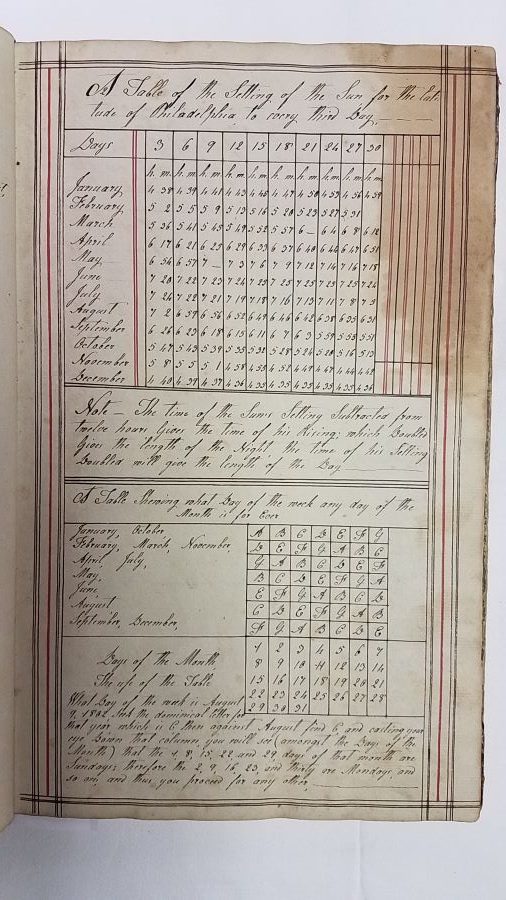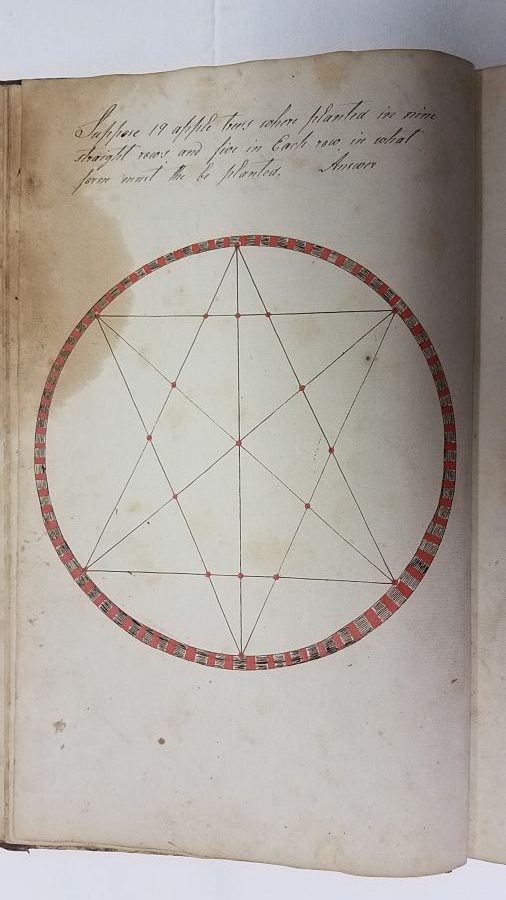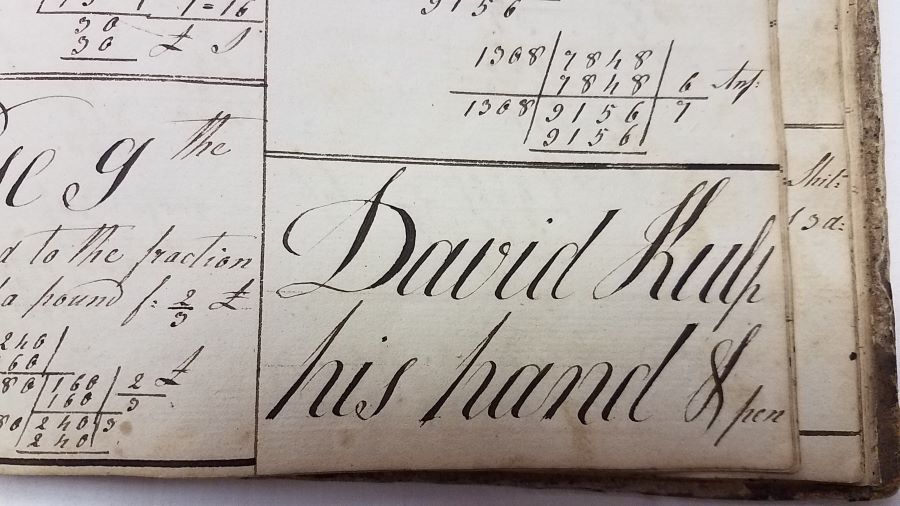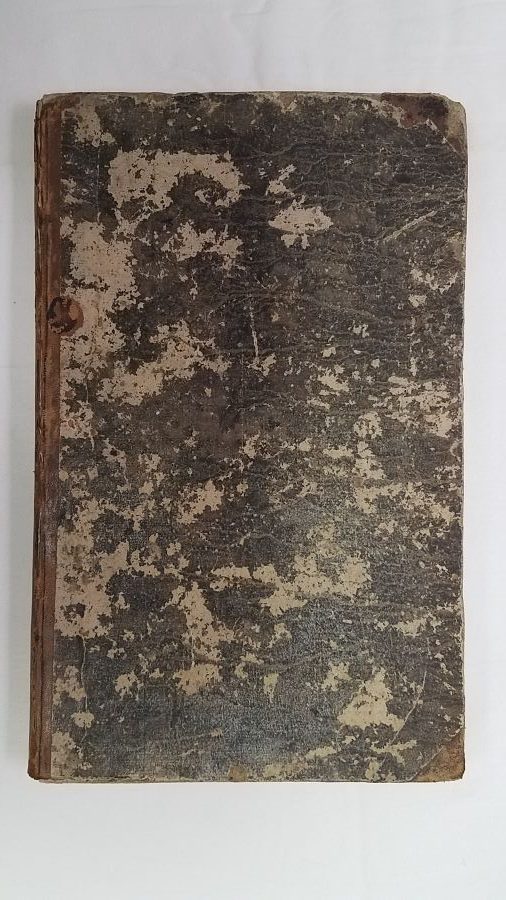How we identify a fraktur artist
Written by Forrest Moyer on April 15, 2020
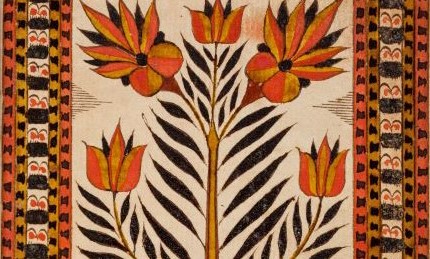
Schoolmasters who made fraktur for their students rarely signed their art. There are numerous artists who have yet to be identified or may never be known; but occasionally, evidence appears which allows historians and collectors to begin attributing artwork to a particular person.
This article, first published in the MHEP Newsletter January 1995 with the title “David Kulp, His Hand & Pen: The ‘Brown Leaf Artist’ Identified?”, describes a process of identification that may be considered typical. In this case, the final clue was a teacher’s record book donated to the Mennonite Heritage Center in 1994.
Written by John L. Ruth & Joel D. Alderfer, 1994
In 1970 a student at Eastern Baptist College, Sylvia Clemens, and family historian Priscilla Delp, while attending an auction of a Leatherman family at Line Lexington, PA, were concerned to see several pieces of fraktur up for sale. Having recently participated in a play, Twilight Auction, which had as a sub-theme the loss of Mennonite heirlooms, Sylvia was emboldened to ask a family member if they might like to donate the fraktur to the Mennonite archives at the Christopher Dock High School. To her delight, consent was given on the spot.
Included in this acquisition of the joint Franconia and Eastern Historical Society (there was as yet no Mennonite Historians of Eastern PA) was a very finely drawn “Harmonic Melody Booklet” made for Sarah Oberholtzer, Singing Scholar in the Deep Run School, in February 1815. (Deep Run is a creek in Bedminster Township, Bucks County, PA — the center of an old Mennonite community).
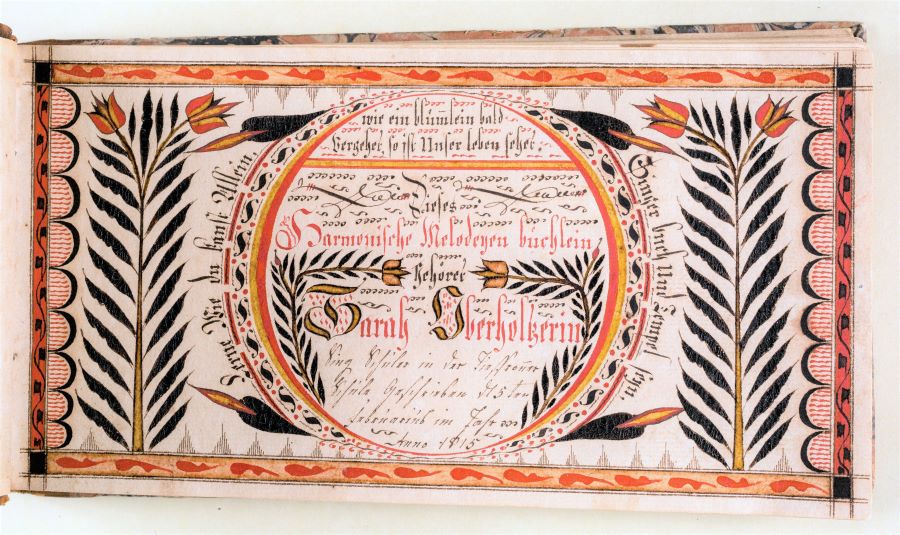
Later, when the MHEP had a fraktur room in the Mennonite Heritage Center at Souderton, Mary Jane and Hiram Hershey loaned a Notenbüchlein by the same hand, and with the same design, made for Henrich Meyer of the Bedminster School in October 1804.

Even this dual evidence of exceptionally fine art-work on the title pages might not have seemed remarkable had it not been that another piece by the same hand could be seen in Donald Shelley’s 1961 book on Fraktur (a bookplate for Catharina Gerhart, illustration #44, The Fraktur-Writings or Illuminated Manuscripts of the Pennsylvania Germans).
As we looked through the Mercer collection in Doylestown and the Free Library in Philadelphia, in preparation for the 1971 Fraktur exhibition at the Christopher Dock Bicentennial, more and more delicate pieces from the same surehanded pen were in evidence. Over the years one began to see published references to the schoolmaster behind these designs as “The Brown Leaf Artist”. His favorite colors were black, brown [now thought to be green darkened with age], yellow, red and orange.
Two copy books
In 1976 another significant donation to the MHEP, from the collection of Norman Wismer of Sellersville, was a beautifully arranged ciphering book, entirely in fine English script…. This book was certainly not the work of a mere pupil, and we displayed it in a number of exhibits. Carrying dates around 1805-07, it was signed here and there with the name of David Kulp. Its excellent English script did not especially connect it with any other materials in our collection.
Now [in 1994], with the acquisition of a second ledger-size ciphering and copy book from the pen of David Kolb/Kulp during recent months (from donor Claude B. Bishop) this perception has changed. Its fine German script at once struck Librarian-curator Joel Alderfer as that of the elusive Brown Leaf Artist. And a cursory check of the dates it contains places it in the hands of the teacher at the Mennonite schools at Deep Run and Perkasie (Blooming Glen) — in the very months and years when the finest singing school books from the pen of this Artist were done.
David Kulp (1777-1834)
David Kolb/Kulp (1777-1834), son of Henry and Catharine Kolb Kolb of a farm in Bedminster Township , was nurtured at the epicenter of a remarkable local Fraktur tradition…. Living just west of the Tohickon, it was David Kulp’s lot to be taught at the Deep Run School, where he first appears in the roll book of Schoolmaster Johann Adam Eyer at the age of five and a half in August of 1782. David was six years old when, at the very end of his second term, on May 8, 1783, his schoolmaster made a lovely bookplate for the new Marburger Gesangbuch of David Kolb.
When he was about nine, David’s father Henry died. Having grown up to marry Mary Landis, David himself became a schoolteacher, scrivener and Township auditor, appraiser and assessor. David and Mary Landis Kulp did not have any children. After he died at the age of 57, Mary married his first cousin, of the same name — David Kulp. His ciphering/copy book of 1805ff, when he was about 28, is the one we have displayed a number of times in our various MHEP exhibits, because of its fine writing and design. But it is the second book of 1805-1822, written partially in German script — only recently donated to our archives — that provides a kind of rosetta stone confirming Kulp’s identity as the Brown Leaf Artist….

These two manuscript records draw us closer than ever to the supplementary roles of a school master who could write well, in a community where few others did. The atmosphere of learning while crossing from “Dutch” to English and back again is very much in evidence. Here are a few quotes from David Kulp’s pen: “Labour for learning before you get Old,/ For learning is better than Silver and gold,/ Say’s I David Kulp” [1806]. Again, “A man without money, Leaming or Vit, / To travel the world is Werry unfit.” (Some of us can still hardly say Willow Valley right.) “David Kulp, his hand and pen, / He will be a Scholler, but Deer nose when” [1806]. “A man Without money and none he can Borrow, / Small is his Creadit and Great is his Sorrow.” Or, finally, “David Kulp, His hand and pen, / Beet it if You can, Januari 22th 1806.”


“Preceptor bin ich genannt”
He writes down several familiar poems, including the song called on a later local broadside “Des Schulmeister’s Leibstück [The Schoolmaster’s Favorite Piece]”. This poem, beginning “Preceptor bin ich genannt [They call me preceptor]” is earliest known in a singing school book that teacher Andreas Kolb made for a pupil at the Swamp School in 1788 (as noted by Suzanne E. Gross of Los Angeles in her 1994 doctoral thesis) . It appears again and again in later hymn-tune booklets, and on several broadsides. Since it is not found in the German hymnbooks of those years, the likelihood appears that this may have been written by Andreas Kolb himself, who was a bachelor second-cousin once removed of David Kulp.
“Preceptor bin Ich Genannt”
Rough translation by John Ruth
Preceptor they title me,
Because I teach the children;
The single life well pleases me
And is indeed my honor.
And when the class is singing
I hear my very joy.
Although I may not please all men
If I may only please my God,
This is my true desire,
And this is my delight.
And that is my desire and joy,
That I to God am faithful,
Away, you worldly minded folk,
Your joy will quickly vanish
And what we’re here possessing,
Will last but little while.
So turn your thoughts to other things,
And do not treasure earthly things
While youth remains your portion,
Let the world go.


Although this roughly rhymed song, purportedly the sentiments of a pious unmarried teacher, is unrecorded in other communities, it was so well preserved around here that elderly Sally G. Moyer Landis (1867-1962) of Franconia Township could still sing it as late as 1960.
Bucks County teacher
David Kulp’s copy books suggest the variety of his roles as teacher, scrivener, auction-clerk, auditor, appraiser and assessor. He was more skilled in both English and German than the little snippets quoted above might suggest, and was employed accordingly at both Birkenseh (Perkasie or Blooming Gen) and Tieffron (Deep Run) schools, which were largely Mennonite. He kept records of the Agreements he made with school directors. The following is one of those agreements:
An 1815 Accord between Schoolteacher David Kolb and Bedminster Township School Directors.
Translated by John Ruth:
God Willing, [Das Wall Gott]
Today, on the date of March 8, 1815, a proper agreement between the school directors of the school in Bed. Township, otherwise named Deep Run, of the one part and David Kolb of the other part, presently schoolteacher at Perkasie, is concluded as follows:
–First. The above-mentioned school directors, in the name of their brethren, accept the above mentioned David Kolb for their schoolteacher for an ordinary quarter-year term off and on, and promise to have a suitable schoolhouse emptied that will be fit and pleasant for the regular holding of school,
–Second. They promise him D. K. according by the power of this accord that he shall be rightly paid for the remaining registered children from every one promised without application … except in case of sickness, from each child the sum of one dollar and fifty cents, in silver or gold. […daß ihm die nach stehend aufgeschrieben Kinder von Jedem der verspricht ohnangesehen, einiges vorwauds oder geschaffts :/ In Krankheit ausgenommen, :/ Richtig bezahlt werden sollen….]
–Third. They promise to supply the schoolhouse with sufficient firewood,
–Fourth. The above-mentioned D. K. reserves free for himself all Saturdays, and that when he leaves this place, and nothing unbecoming is attributed to him, an authentic written recommendation shall and must be given him,
–Conversely, The above-mentioned schoolteacher promises by God’s grace and help to begin his service here by the next May 22, and to proceed for a quarter year, and to regard the children as precious pledges made to him [und die Kinder als theure ihm anvertraute pfander anzusehen] and to instruct them with untiring diligence in reading, writing, singing and reckoning to the end of each child’s salvation, and further to acquaint them with good and Christian morals, to the extent that the almighty God imparts his grace.
–Beyond this it is decided that if fewer than 40 children are registered and promised, this agreement, according to the subscribers, shall be without force and invalid. However, if 40 or more children are promised, it shall be and remain valid.
–In confirmation of this agreement we of either party have personally subscribed on the day and date mentioned at the beginning, subscribed in our presence.
D. K. Schuld[iener]
I. M.
D.K.
M. F.
A. M.
A more detailed article about the identification of David Kulp was published by Joel Alderfer in the book Bucks County Fraktur, edited by Cory Amsler (Doylestown, PA: Bucks County Historical Society, 2000) pp 151-165.



